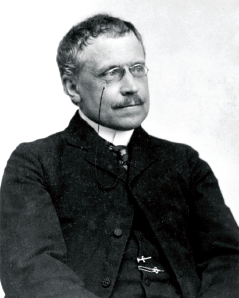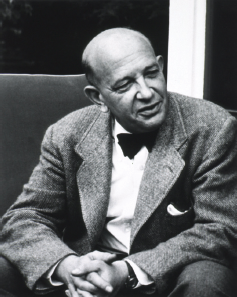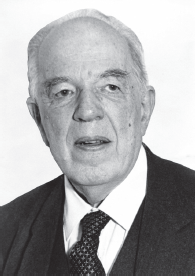Before the emergence of a systematic science of the brain in the second half of the twentieth century, researchers relied on psychology and on the emerging understanding of visual perception to investigate the workings of the human mind. One focus of inquiry was on an activity that is quintessentially human—how we perceive and create works of art.
This raised the question: Can any aspect of art, which is a creative and subjective experience, be studied objectively? To answer this, and to understand how abstract art relates to this inquiry, we must first explore what we know about how the mind responds to figurative art, which more closely resembles our natural world.
The question of how we respond to figurative art was first addressed by Alois Riegl (
fig. 2.1), Ernst Kris, and Ernst Gombrich at the Vienna School of Art History. Riegl, Kris, and Gombrich attained international renown at the turn of the twentieth century for their efforts to establish art history as a scientific discipline by grounding it in psychological principles (Riegl 2000; Kris and Kaplan 1952; Gombrich 1982; Gombrich and Kris 1938, 1940; see also Kandel 2012).
2.1 Alois Riegl (1858–1905)
Riegl emphasized an obvious but previously ignored psychological aspect of art: that art is incomplete without the perceptual and emotional involvement of the viewer. Not only do we collaborate with the artist in transforming a two-dimensional figurative image on a canvas into a three-dimensional depiction of the visual world, we interpret what we see on the canvas in personal terms, thereby adding meaning to the picture. Riegl called this phenomenon the “beholder’s involvement.” Based on ideas derived from Riegl’s work and on insights that began to emerge from cognitive psychology, the biology of visual perception, and psychoanalysis, Kris and Gombrich (
figs. 2.2,
2.3) went on to develop a new view of this concept, which Gombrich referred to as the
beholder’s share.
Kris, who later became a psychoanalyst, started things off by studying ambiguity in visual perception. He argued that every powerful image is inherently ambiguous because it arises from experiences and conflicts in the artist’s life. The viewer responds to this ambiguity in terms of his or her own experiences and conflicts, recapitulating in a modest way the experience of the artist in creating the image. For the artist, the creative process is also interpretative, and for the beholder the interpretative process is also creative. Because the extent of the viewer’s contribution depends on the degree of ambiguity in the image, a work of abstract art, with its lack of reference to identifiable forms, arguably puts greater demands on the beholder’s imagination than a figurative work does. Perhaps it is these demands that make abstract works seem difficult to some viewers, yet rewarding to those who find in them an expansive, transcendent experience.
2.2 Ernst Kris (1900–1957)
2.3 Ernst Gombrich (1909–2001)
Gombrich embraced Kris’s ideas about the beholder’s response to the ambiguity in a painting and extended them to all visual perception. In the process, he came to understand a crucial principle of brain function: our brain takes the incomplete information about the outside world that it receives from our eyes and makes it complete.
As we shall see in
chapter 4, the image on our retina is first deconstructed into electrical signals that describe lines and contours, creating a boundary around a face or an object. As these signals move through the brain, they are recoded and, based on Gestalt rules of organization and on prior experience, they are reconstructed and elaborated into the image we perceive. Amazingly, each of us is able to create a rich, meaningful image of the external world that is remarkably similar to the image seen by others. It is in the construction of these internal representations of the visual world that we see the brain’s creative process at work. As the cognitive psychologist Chris Frith of the Wellcome Center for Neuroimaging at University College London writes:
What I perceive are not the crude and ambiguous cues that impinge from the outside world onto my eyes and my ears and my fingers. I perceive something much richer—a picture that combines all these crude signals with the wealth of past experience. . . . Our perception of the world is a fantasy that coincides with reality. (Frith 2007)
Any image projected onto the retina of the eye has countless possible interpretations. The Anglo-Irish philosopher George Berkeley, Bishop of Cloyne, grasped this central problem of vision as early as 1709, when he wrote that we do not see material objects, but rather the light reflected off them (Berkeley 1709). As a result, no two-dimensional image projected onto our retina can ever directly specify all three dimensions of an object. This fact, and the difficulty it raises for understanding our perception of any image, is referred to as the inverse optics problem (Purves and Lotto 2010; Kandel 2012; Albright 2013).
The inverse optics problem arises because any given image projected onto the retina can be generated by objects of different sizes, with different physical orientations, and at different distances from the observer. For example, a souvenir model of the Eiffel Tower held close to your eye may appear identical in shape and size to the actual Eiffel Tower as seen from across the Champ de Mars. As a result, the actual source of our perception of any three-dimensional object is inherently uncertain. Gombrich fully appreciated this problem and cited Berkeley’s observation that “the world as we see it is a construct slowly built up by every one of us in years of experimentation” (Gombrich 1960).
Although our brain does not receive enough information to reconstruct an object accurately, we do it all the time—and with surprising consistency from person to person. How does this occur? The noted nineteenth-century physician and physicist Hermann von Helmholtz argued that we solve the inverse optics problem by including two additional sources of information: bottom-up information and top-down information (see Adelson 1993).
Bottom-up information is
supplied by computations that are inherent in the circuitry of our brain. These computations are governed by universal rules that are largely built into the brain at birth by biological evolution and enable us to extract key elements of images in the physical world, such as contours, intersections, and the crossings of lines and junctions. Edward Adelson (1993) and subsequently Dale Purves (2010), two students of vision who have revisited the inverse optics problem, conclude that our visual system must have evolved primarily to solve this fundamental problem. We use these rules to discern objects, people, and faces; to ascertain their placement in space (perspective); to reduce ambiguity; and ultimately to construct visual worlds of great subtlety, beauty, and practical value. As a result, each person’s visual system extracts pretty much the same essential information from the environment. This is why, despite incomplete information and potential ambiguities, even young children can interpret images quite accurately. It is also why babies can recognize human faces very early in their lives.
Many of these innate rules we take for granted. For example, our brain realizes that the sun is always above us, no matter where we are. We therefore expect light to come from above. If it does not—as in a visual illusion—our brain can be tricked.
As the psychologist of art Robert Solso has written, bottom-up perception is simply a matter of nativist perception: “People have certain inborn ways of seeing, in which visual stimuli, including art, are initially organized and perceived. Causally speaking, nativist perception is ‘hard-wired’ in the sensory-cognitive system” (Solso 2003). Bottom-up information processing depends largely on low- and intermediate-level vision (Kandel 2012). Abstract art, as we will see, subverts the innate rules of perception and relies more extensively on top-down information than does figurative art.
Top-down information refers to cognitive influences and higher-order mental functions such as attention, imagery, expectations, and learned visual associations. Because bottom-up processing cannot resolve all of the perplexing information we receive from our senses, the brain must engage top-down processing to resolve the remaining ambiguities. We must guess, based on experience, the meaning of the image in front of us. Our brain does this by constructing and testing a hypothesis. Top-down information places the image into a personal psychological context, thereby conveying different meanings about it to different people (Gilbert 2013; Albright 2013).
Top-down processing is also critical for suppressing components of the visual scene that we unconsciously deem irrelevant. Our recognition of an image takes place serially; it requires us to shift the focus of our attention frequently, linking relevant components of the scene and suppressing irrelevant components. Thus the creativity of the beholder’s share that Kris described derives in large part from top-down processing.
Perception incorporates the information our brain receives from the external world with knowledge based on learning from earlier experiences and hypothesis testing. We bring this knowledge—which is not necessarily built into the developmental program of our brain—to bear on every image we see. Thus when we look at an abstract work of art, we relate it to our entire life experience of the physical world: people we have seen and known, environments we have been in, as well as memories of other works of art we have encountered.
Frith summarizes Helmholtz’s insight into the nature of visual perception in this way: “We do not have direct access to the physical world. It may feel as if we have direct access, but this is an illusion created by our brain” (Frith 2007).
In a sense, to see what is represented by the paint on a canvas, we have to know beforehand what sort of image we might expect to see in a painting. Our familiarity with the natural environment, as well as with centuries of landscape paintings, helps us to discern almost immediately a wheat field in the brushstrokes of Vincent van Gogh or a lawn in the Pointillist dots of Georges Seurat. In this way the artist’s modeling of physical and psychic reality parallels the intrinsically creative operations of our brain in everyday life.



